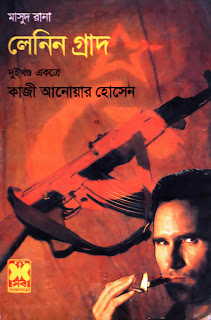About Masud Rana Series
Masud Rana is an adult spy-thriller series penned by the famous Bangladeshi novelist Qazi Anwar Husain. Anwar Hussain started writing this series from the 1960s and still continuing to date. All Masud Rana books have been published from his own publication house, Sheba Prokashoni. Qazi Anwar Hussain debuted this series with the publication of Dhongsho-pahaar (1965), which is the pioneer of spy thrillers written in Bangla. Dhongsho-pahaar got an immediate audience attention and as such paved the way for creating one of the most enduring Bangladeshi version of a world-class spy character, namely Masud Rana.Before Anwar Hussain none could even imagine of writing a spy thriller in Bangla. Up to that point, the Bangladeshi book market was stuffed with thrillers and detective stories from the writers of West Bengal, India. However, Hussain’s initiative changed the whole scenario; the audience could experience suspenseful stories without resorting to imported books. The Masud Rana series even got very popular in Kolkata, which was definitely a great achievement for Bangladesh.
Hussain adopted the name for his protagonist from various sources. He took the first name from his friend, lyricist Masud Karim. On the other hand he took the last name from Rana Pratap Singh of the Rajput clan who ruled Mewar, a state in north-western India from 1540 to 1597.
The central character, Masud Rana, a former major of the Bangladesh Army, currently commander stationed for HUMINT at BCI (Bangladesh Counter Intelligence) HQ, Dhaka. He works under direct command of Major General (retired) Rahat Khan of the fictitious Bangladesh Counter Intelligence (BCI).
According to the series, Rana is also founder and director of an international investigating firm named Rana Agency, which is a front cover for BCI in the form of a private investigation agency.
Masud Rana was born in Dhaka, Bangladesh to Justice Imtiaz Chowdhury and Jahanara Imtiaz Chowdhury. Rana was orphaned at the age of 13 when his parents were killed in a car accident near Chittagong, Bangladesh. After the death of his parents, Rana went to live with his aunt, Ismat ara, in Fort William, Highland. Later, he briefly attends Eton College in his college days.
In the very beginning Anwar Husain planned to mould his novels based on original stories. However, since he had a plan to publish one book per month, he had to switch to adaptation to save time. Masud Rana books have been adapted from renowned thriller writers from all around the world, such as Ian Fleming, Alistair MacLean, James Hadley Chase, Clive Cussler, Frederick Forsyth, etc.
Although Qazi Anwar Hussain started the series, it is widely known that he is not anymore a contributor to this. A group of ghostwriters are employed to write all the new Masud Rana novels.
Over the past few decades Sheba Prokashoni has published considerable number of Masud Rana books. Today we are sharing one of them, which is Leningrad (Masud Rana 111, 112) by name. Hope you will thoroughly enjoy it.
Book Details
- Leningrad Part-1 (1983)
- Leningrad Part-2 (1983)
Story: NA
Publisher: Sheba Prokashoni
First Published: 1983
ISBN: 984-16-7111-5
File Format: .pdf
File Size: 14.1 MB











